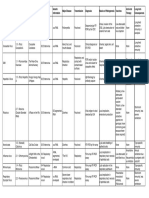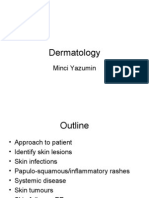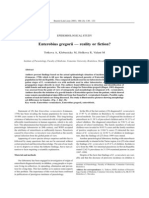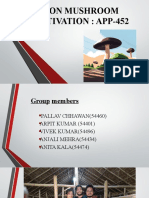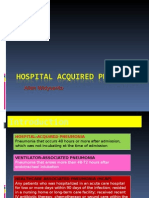0 ratings0% found this document useful (0 votes)
69 viewsBacteria List Exam 1 PDF
Bacteria List Exam 1 PDF
Uploaded by
JamesHowsonStaphylococcus aureus is a gram-positive coccus that can cause several diseases through direct infection or toxin production. It is commonly found on the skin and in the nose of healthy individuals but can opportunistically infect wounds or the bloodstream. Diagnosis involves gram stain and culture of infected sites. Treatment focuses on antibiotics like vancomycin for serious infections, though MRSA strains are increasingly resistant. Proper hygiene and wound care can prevent transmission and infection.
Copyright:
© All Rights Reserved
Available Formats
Download as PDF, TXT or read online from Scribd
Bacteria List Exam 1 PDF
Bacteria List Exam 1 PDF
Uploaded by
JamesHowson0 ratings0% found this document useful (0 votes)
69 views16 pagesStaphylococcus aureus is a gram-positive coccus that can cause several diseases through direct infection or toxin production. It is commonly found on the skin and in the nose of healthy individuals but can opportunistically infect wounds or the bloodstream. Diagnosis involves gram stain and culture of infected sites. Treatment focuses on antibiotics like vancomycin for serious infections, though MRSA strains are increasingly resistant. Proper hygiene and wound care can prevent transmission and infection.
Original Title
Bacteria_List_Exam__1.pdf
Copyright
© © All Rights Reserved
Available Formats
PDF, TXT or read online from Scribd
Share this document
Did you find this document useful?
Is this content inappropriate?
Staphylococcus aureus is a gram-positive coccus that can cause several diseases through direct infection or toxin production. It is commonly found on the skin and in the nose of healthy individuals but can opportunistically infect wounds or the bloodstream. Diagnosis involves gram stain and culture of infected sites. Treatment focuses on antibiotics like vancomycin for serious infections, though MRSA strains are increasingly resistant. Proper hygiene and wound care can prevent transmission and infection.
Copyright:
© All Rights Reserved
Available Formats
Download as PDF, TXT or read online from Scribd
Download as pdf or txt
0 ratings0% found this document useful (0 votes)
69 views16 pagesBacteria List Exam 1 PDF
Bacteria List Exam 1 PDF
Uploaded by
JamesHowsonStaphylococcus aureus is a gram-positive coccus that can cause several diseases through direct infection or toxin production. It is commonly found on the skin and in the nose of healthy individuals but can opportunistically infect wounds or the bloodstream. Diagnosis involves gram stain and culture of infected sites. Treatment focuses on antibiotics like vancomycin for serious infections, though MRSA strains are increasingly resistant. Proper hygiene and wound care can prevent transmission and infection.
Copyright:
© All Rights Reserved
Available Formats
Download as PDF, TXT or read online from Scribd
Download as pdf or txt
You are on page 1of 16
Staphylococcus aureus
Physical Characteristics Associated Diseases Transmission Patients at Risk
• Impetigo • Host = humans • Extremes of age
• Furunculosis • In adults: carried in anterior • Diseases ↓ local resistance
• Surgical wound infections nares, on skin, or vaginally • Granulocyte absence or
• Bacteremia • In neonates: carried in malfunction
• Pneumonia (1o & 2o) umbilicus, perineum, skin, or • Presence of foreign bodies
• Endocarditis GI tract • Antibiotic therapy
• Large Gram (+) cocci in • Osteomyelitis • Person-to-person hand • Encounter with health care
grape-like clusters
contact; inanimate objects system
• Catalase (+); Coagulase (+) Toxin-mediated Disease: • Attachment via fibronectin
• Resistant to harsh • Food poisoning • Abscess formation &
conditions • Toxic Shock Syndrome bloodstream invasion after
• β-hemolytic (produces • Scalded Skin Syndrome acute inflammatory response
golden yellow pigment)
Virulence Factors Diagnosis Treatment & Prevention Related Organisms
• Capsule (polysaccharide) • Gram stain • High incidence of antibiotic • There are 27 recognized
• Peptidoglycan • Culture resistance - Methicillin- species of Staphyococcus
• Teichoic acid (TA) & • Lab tests resistant strain (MRSA) • S. epidermidis = Coagulase
lipoteichoic acid (LTA) • Vancomycin, especially (-); Sensitive to novobiocin;
• Protein A Causes device & implant
for serious infections with
•Fibronectin-binding surface assoicated infection &
MRSA
proteins bacteremia; Common skin
• Warm compresses +/-
• Collagen adhesion protein commensal - nosocomial
topical antibiotics; drain pus;
• Fibrinogen binding protein • S. saprophyticus =
remove foreign body;
• Extracellular Factors: Coagulase (-); γ-hemolytic;
appropriate antibiotic
Toxins include Enterotoxins Causes UTIs; Resistant to
Coagulase, Catalase, coverage; supportive care
A-E, G-I, exfoliating toxins, & novobiocin
Hemolysins, Leukocidins,
toxic shock syndrome toxin
Hyaluronidase, Fibrinolysin,
(TSST-1)
Toxins, Biofilm production
Streptococcus pyogenes (Group A)
Physical Characteristics Associated Diseases Transmission Patients at Risk
• Pharyngitis • Host = humans • Colder months/climates =
• Scarlet fever • Carried in nasopharynx pharyngitis
• Impetigo/pyoderma • Transmission via respiratory • Warmer months/climates =
• Erysipelas route or physical contact cutaneous infections
• Necrotizing fasciitis • Attachment via surface
• Streptococcal toxic shock ligands • Crowding
• Gram (+) cocci forming syndrome with Bacteremia • Cell structures are cross- • Poor hygiene
chains reacting antigens • Specific immunogenetic
• Catalase (-) Non-infectious complications: • Can act as superantigen predispositions
• β-Hemolytic • Glomerulonephritis (after
• Bacitracin-sensitive pharyngitis or cutaneous
infection)
• Acute rheumatic fever (after
pharyngitis)
Virulence Factors Diagnosis Treatment & Prevention Related Organisms
• Depends on diagnostic • S. agalactiae (Group B
• Capsule (hyaluronic acid) • Gram stain
testing & clinical presentation strep) = Causes neonatal
• M Protein on fimbriae • Culture
• For pharyngitis, 10 day sepsis & bacteremia &
• Lipoteichoic acid • Serology - anti-DNAase &
course of penicillin or meningitis
• C5a endopeptidase anti-streptolysin O antibody
• S. pneumoniae = α-
• Extracellular Factors: detection equivalent
Streptolysins O & S, • Rapid testing for antigen hemolytic; Causes pneumonia,
• For invasive disease,
Hyaluronidase, meningitis, & URT infections;
surgical intervention +
Streptokinase, DNAase, Encapsulated; optochin
antibiotics
NADase, Streptococcal sensitive
pyrogenic exotoxins, • Enterococcus faecalis =
• Vaccine development in
Streptococcal inhibitor of non-hemolytic; Nosocomial
progress, but complicated
complement (SIC) pathogen (UTI, bacteremia,
endocarditis, wound infection)
• S. viridans = α-hemolytic;
normal flora; optochin resistant
Neisseria gonorrhoeae
Physical Characteristics Associated Diseases Transmission Patients at Risk
Local Diseases: • Host = humans • Southern & Central states
• Urethritis • Asymptomatic carriers: • Large cities
• Proctitis Female > Male • 15-30 year old age group
• Cervicitis • Transmission by sexual • Single
• Gram (-) diplococci • Ophthalmitis (esp. contact; also by “innocent” • Lower socioeconomic
• Fastidious anaerobe neonates) non-sexual contact & perinatal status
• Oxidase (+) • Pharyngitis • Attachment to microvilli of • # of sexual encounters &
non-ciliated cells → adjacent possible exposures
Disseminated Diseases: ciliastasis & sloughing off
• Peritonitis & Pelvic • Internalized & transport
Inflammatory Disease (PID) across cells in vacuoles
• Skin & joint disease via • Elicits intense inflammatory
bloodstream invasion response once in CT
Virulence Factors Diagnosis Treatment & Prevention Related Organisms
• Pili • Gram stain - urethral • Antibiotic resistance a major • Neisseria meningitidis
• Capsule (polysaccharide) discharge or pharynx problem - CDC has guidelines
• Endotoxin • Culture on specialized for current recommended tx
• Porin B media (Thayer-Martin) (changes over time)
• Opacity-associated enriched with elevated CO2 • Cephalosporin,
proteins & antibiotics to suppress ceftriaxone, cefixime, or
• IgA1 Proteases growth of competing bacteria alternative to treat
• Immunological methods uncomplicated cases
Rapid genotypic & • Molecular techniques • Azithromycin or
phenotypic changes to
surface proteins including pili doxycycline to treat co-
& capsule infection with Chlamydia
trachomatis
• Prevention = Safe sex
Neisseria meningitidis
Physical Characteristics Associated Diseases Transmission Patients at Risk
Local Diseases: • Host = humans • Infants (1-5 years) &
• Rare upper respiratory • Mainly endemic in US; adolescents (12-18 years)
diseases (epiglotitis) epidemic in 3rd world • Crowding & close contact
• Pneumonia countries (dorms & army)
• Gram (-) diplococci • Carried in nasopharynx • Immune status
• Fastidious anaerobe • Transmission via respiratory
Disseminated Diseases: • Complement deficiency
• Oxidase (+) route (requires close contact)
• Meningitis • Colder climates favor
• 13 serotypes - A, B, & C • Attachment to non-ciliated
• Bacteremia transmission
associated with meningitis cells & M cells → local
epidemics • Fulminant disease
(meningococcemia = purpuric damage to ciliated cells
rash/lesions) • Minimal local inflammatory
response; asymptomatic
localized infection
• Crosses blood-brain barrier
Virulence Factors Diagnosis Treatment & Prevention Related Organisms
• Pili • Gram stain - CSF • Penicillin G or antibiotic • Neisseria gonorrhoeae
• Capsule (polysaccharide)** • Culture on specialized with better pharmacokinetics
• Endotoxin media (Thayer-Martin) (e.g. ceftriaxone,
• Porin B enriched with elevated CO2
• Opacity-associated rifampin, ciprofloxacin)
& antibiotics to suppress
proteins
growth of competing bacteria • Antibiotics prophylaxis for
• IgA1 Proteases
close contacts
Rapid genotypic & • Vaccination - polysaccharide
phenotypic changes to vs. conjugate form
surface proteins including pili
& capsule
Haemophilus influenzae
Physical Characteristics Associated Diseases Transmission Patients at Risk
• Non-vaccinated people
• Bacteremia • Host = humans • Bimodal seasonal variation -
• Meningitis • Carried in nasopharynx peaks Sept to Dec & March
• Epiglottitis • Transmission via
• Small Gram (-) coccobacilli to May
• Septic arthritis respiratory route & direct
• Highly pleomorphic in tissue • Immune status
• Cellulitis contact
& body fluids • Genetic predisposition
• Otitis media • Attachment to non-ciliated
• Fastidious - requires linked to specific blood group
• Sinusitis epithelial cells → ciliastasis,
hematin & NAD; growth phenotypes & HLA antigens
• Conjunctivitis cilia sloughing & tight
enhanced by CO2 • Underlying pulm. disease
junction breakdown • Day care, elementary-aged
• Both encapsulated & • Invades between cells or younger siblings, smoke
nonencapsulated strains exposure
• 6 serotypes - Type B most • Antecedent resp. viral
invasive infection
Virulence Factors Diagnosis Treatment & Prevention Related Organisms
• Capsule - Type B is • Gram stain - better if • 40% are ampicillin resistant
polyribitol phosphate samples from CSF or ear • Non-invasive disease =
• Endotoxin then respiratory tract Doxycycline/quinolones
• IgA1 Protease • Culture - requires special • Invasive disease = 3rd
• Pili & other surface conditions generation cephalosporins
adhesions • Direct detection (ceftriaxone &
• Quellung test
cefotaxime)
• HiB Vaccine (conjugate
containing PRP capsule)
Bordetella pertussis
Physical Characteristics Associated Diseases Transmission Patients at Risk
Catarrhal phase (1-3 weeks • Countries where vaccination
• Host = humans
post exposure): is not available (3rd world)
• Carried in nasopharynx
• Upper respiratory illness • Very young children - lack of
• Carriage is transient
symptoms including malaise, a fully developed immune
• Tiny Gram (-) coccobacilli • Maintains reservoir even in
low-grade fever, rhinorrhea & system
• Slow growing & fastidious immunized populations
watery eyes • Adults (as immunity from
• Transmission via respiratory
route (highly contagious) vaccine wears off)
Paroxysmal phase (3+ weeks): • Immune status
• Attachment to ciliated
• Episodes of coughing with no • Female > Male (unknown
epithelium → Ciliostasis &
time to breathe followed by reason)
local cell damage
inspiratory gasp
• Mainly a localized disease
• Lymphocytosis
• Secondary pneumonia
• Subconjunctival hemorrhage
Virulence Factors Diagnosis Treatment & Prevention Related Organisms
• Endotoxin • Nasopharyngeal swab (not • Erythromycin or
• Filamentous cotton) trimethoprim-
hemagglutinin** • Culture - difficult & tedious sulfamethoxazole in
• Tracheal cytotoxin b/c NAD required for growth Catarrhal phase
• Heat labile toxin • Serology for specific • Supportive therapy: close
• Adenylate cyclase antibodies monitoring of vitals,
• Pertussis toxin** • Direct detection & PCR nasotracheal suctioning,
• Capsule available but not used often oxygen, parenteral nutrition, &
• Clinical case definition is hydration
often the only basis used
• Vaccination - whole cell
(DPT) vs. acellular
• Antibiotic prophylaxis for
family
Corynebacterium diphtheriae
Physical Characteristics Associated Diseases Transmission Patients at Risk
• Pharyngitis • Host = humans • Non-vaccinated
• Hypoxia • Carried in nasopharynx or • Children
• Fever on skin • Immuno-compromised
• Lymphadenitis • Transmission via
• Diptheria respiratory route
• Gram (+) bacilli • Bacteria remain localized
(pseudomembrane in
• Toxigenic & non-toxigenic but toxins spread via blood
pharynx)
strains
• Catalase (+)
Systemic Complications:
• Faculative anaerobe
• Toxic peripheral neuropathy
• Toxic myocarditis &
congestive heart failure
Virulence Factors Diagnosis Treatment & Prevention Related Organisms
• Diphtheria toxin - regulated • Gram stain • Penicillin or
by environmental factors • Culture erythromycin
• Pseudomembrane • Phage typing
formation • Vaccination (DPT)
• Passive immunization with
anti-toxin sera
Pseudomonas aeruginosa
Physical Characteristics Associated Diseases Transmission Patients at Risk
• Localized infections • Inhabits soil, water, &
• Immunocompromised due
following surgery or burns vegetation
to underlying disease or
• Bacteremia • Transmission via hand
breakdown of nonspecific
• UTIs contact with hospital
host defenses
• Eye & Ear infections personnel
• Gram (-) bacilli • CNS infections • Opportunistic pathogen -
• Have flagellum - motile • Endocarditis nosocomial
• Obligate aerobe that can • Chronic respiratory
also grow anaerobically, at infection in cystic fibrosis
42oC & at high salt conditions patients
• Oxidase (+) • Acute pneumonia
Virulence Factors Diagnosis Treatment & Prevention Related Organisms
• Flagella • Gram stain • Resistant to many antibiotics
• Pili • Culture - greenish-metallic • Combined use of
• Endotoxin appearing colonies on blood aminoglycoside & a
• Toxin A agar with fruity (grape) smell beta-lactam antibiotic
• Extracellular enzymes (gentamicin,
including heat-stable carbenicillin)
hemolysin, phospholipase C, • Topical therapy of burn
pigments (pyocyanin & wounds
fluorescein), proteases
(elastase & alkaline protease), • Aseptic techniques
exoenzyme S, leukocidin
Listeria monocytogenes
Physical Characteristics Associated Diseases Transmission Patients at Risk
• Listeriosis • Transmission via ingestion • Immunocompromised &
• Sepsis & Septicemia of raw contaminated food or Elderly
• Meningitis vaginally during childbirth • Pregnant women
• Encephalitis • Can grow extra- & • Fetuses - can spread
intracellularly congenitally across placenta
• Gram (+) bacilli • Intracellular survival or be acquired during labor &
• Has flagella - motile depends on hemolysin delivery
• Can grow at low • Stays localized except in
temperatures immunocompromised
• Catalase (+) patients
• β- Hemolytic
• Facultative anaerobe
Virulence Factors Diagnosis Treatment & Prevention Related Organisms
• H-antigen on flagella • Gram stain • High doses of Penicillin
• Hemolysin • Culture or Ampicillin +/-
• Listeriolysin O Gentamicin
• Phospholipases
• Hygienic food processing &
storage
• Avoid uncooked food
Chlamydia trachomatis
Physical Characteristics Associated Diseases Transmission Patients at Risk
• Trachoma (Tr) = major • Host = humans • Adults & newborns most
cause of blindness • Life cycle within epithelial susceptible to IC - from
[Serotypes A, B, Ba, C] cell = invasion of elementary genital infection
• Small, obligate intracellular • Inclusion conjunctivitis (IC) body into phagosome → • LGV has higher incidence in
parasites with many [Serotypes A, B, Ba, D to K] conversion to reticulate body males
characteristics of Gram (-) • Lymphogranuloma → multiplication → release • 3rd world countries -
cocci, but lacks peptidoglycan venereum (LGV) [Serotypes of elementary bodies & cell transmission via poor
layer & muramic acid L1, L2, L2a, L3] death hygiene
• No pili or exotoxins • Non-gonococcal urethritis & • Cycle takes ~48 hours
cervicitis (NGU) [Serotypes D • Transmission via direct
to K] contact or contact with
infected fly
Virulence Factors Diagnosis Treatment & Prevention Related Organisms
• Can’t culture artificially, but • Tr: doxycycline or • Chlamydophilia psittaci
• Elementary body
can be grown within certain azithromycin • Chlamydophilia
cell lines pneumoniae
• IC: Adults = doxycycline
• For LGV - specific Ab
detection or direct detection or azithromycin; Pregnant
mothers = azithromycin,
erythromycin, or
amoxicillin
• NGU: doxycycline or
azithromycin
• LGV: doxycycline;
macrolides for young
children, pregnant women, or
people allergic to doxycycline
Chlamydophila psittaci
Physical Characteristics Associated Diseases Transmission Patients at Risk
• Ornithosis (psitticosis) = • Life cycle within epithelial • Bird owners or people who
bronchial viral-like atypical cell = invasion of elementary frequent city parks
pneumonia (high fever, sore body into phagosome →
• Small, obligate intracellular throat, severe headache, conversion to reticulate body
parasites with many photophobia, nausea & → multiplication → release
characteristics of Gram (-) vomiting, irritated eyes, non- of elementary bodies & cell
cocci, but lacks peptidoglycan productive cough) death
layer & muramic acid • Can spread to CNS & also • Cycle takes ~48 hours
• No pili or exotoxins cause lung consolidation • Transmission via inhalation
of dried bird discharge
Virulence Factors Diagnosis Treatment & Prevention Related Organisms
• Can’t culture artificially • Chlamydia trachomatis
• Elementary body • Recovery of agent followed
• Tetracyclines or
• Chlamydophilia
by serology for Ab macrolides pneumoniae
Chlamydophila pneumonia
Physical Characteristics Associated Diseases Transmission Patients at Risk
• Respiratory Tract • Life cycle within epithelial • Immunocompromised
Infections including atypical cell = invasion of elementary people
pneumonia, bronchitis, & body into phagosome →
• Small, obligate intracellular pharyngitis conversion to reticulate
parasites with many • May be involved in body → multiplication →
characteristics of Gram (-) coronary artery disease release of elementary
cocci, but lacks development bodies & cell death
peptidoglycan layer & • Cycle takes ~48 hours
muramic acid • Host = humans
• No pili or exotoxins • Transmission via
• TWAR serotype respiratory route
Virulence Factors Diagnosis Treatment & Prevention Related Organisms
• Elementary body • Can’t culture artificially • Doxycycline or • Chlamydophilia psittaci
• Serology to detect Ab erythromycin • Chlamydia trachomatis
Legionella pneumophila
Physical Characteristics Associated Diseases Transmission Patients at Risk
• Legionnaires’ Disease • Grows in unicellular • Legionnaires’ Disease:
(legionellosis) = multi-system organisms in ground water epidemic from late summer
disease involving headache, • Transmission via inhalation of into early fall & endemic the
cough, fever, pneumonia, aerosolized droplets from rest of the year; ↑ incidence
liver degeneration, cardiac affected water source in males & people with
• Gram (-) bacilli arest, etc. • Invades phagocytic cells → pulmonary problems
• Fastidious • Pontiac Fever = flu-like prevents lysosome fusion & • Pontiac fever is always
• Aerobic syndrome, headache, acidication → multiplication → epidemic & is self-limiting
• Inhibited by high sodium dizziness, muscle pain release & cell death with • Immunocompromised &
concentrations • Forms microabcesses in cytokine release elderly
• Requires L-cysteine & iron lungs which coalesce to form • Can be found in lung or blood
for growth cavities • Several day incubation period
• No person to person
transmission
Virulence Factors Diagnosis Treatment & Prevention Related Organisms
• Type IV secretion system • Cultured on specific solid • Legionellosis:
• Pili agar with low sodium and Fluoroquinolones,
• Flagella high L-cysteine & ferric salt macrolides, or
• Cu-Zn superoxide • Serology
tetracyclines
dismutase & catalase-
• Pontaic fever is not treated
peroxidase
b/c self-limiting
• Toxins (RNAse,
phospholipase A & C)
Mycoplasma pneumoniae
Physical Characteristics Associated Diseases Transmission Patients at Risk
• Normally found in respiratory
• Very small • Atypical pneumonia • Children ages 5-9 years old
& genitourinary tracts
• No cell wall (Walking pneumonia) - to young adults
• Can pass through membrane
• Pleomorphic confined to one lower lobe; • Slow progression &
filters
• Contains plastic membrane involved resp. mucosa; recovery times (weeks)
• Transmission via inhalation
consisting of sterols impairs ciliary function, but • 2-3 week incubation period
or infected droplets from close
• Requires very complex not alveoli function
personal contact with infected
media including cholesterol • Dry cough & remittent fever
• Fuses to cilia to create
& fatty acids superantigen → releases
• Motile (glides) toxic products which damage
• Facultative anaerobe adjacent cells & stimulate
• No toxins inflammatory cells
• Evades host response by
exchanging antigens with host
Virulence Factors Diagnosis Treatment & Prevention Related Organisms
• Protein P1 • Slow cultivation period • Macrolides, • Ureaplasma urealyticum
requiring very complex media Tetracyclines, or • Mycoplasma hominis
• Cold agglutinins Fluoroquinolones
• Complement fixation tests
• Direct detection of sputum
• Patchy infiltrate on CXR
Ureaplasma urealyticum
Physical Characteristics Associated Diseases Transmission Patients at Risk
• Very small • Non-gonococcal urethritis & • Normally found in genital
• No cell wall prostatitis tracts of healthy, sexually
• Pleomorphic • Respiratory disease in active people
• Contains plastic membrane newborns • Passes through membrane
consisting of sterols filters
• Requires very complex • Fuses to cilia to create
media including cholesterol superantigen → releases
& fatty acids toxic products which damage
• Metabolizes urea for adjacent cells & stimulate
growth inflammatory cells
• No toxins • Evades host response by
exchanging antigens with
host
Virulence Factors Diagnosis Treatment & Prevention Related Organisms
• Slow cultivation period Doxycycline, • Mycoplasma pneumonia
requiring very complex media • Mycoplasma hominis
azithromycin,
erythromycin, or
levofloxacin
Mycoplasma hominis
Physical Characteristics Associated Diseases Transmission Patients at Risk
• Pelvic inflammatory • Normally found in genital
• Very small
disease (PID) tracts of healthy sexually-
• No cell wall
• Postabortal & postpartum active people
• Contains plastic membrane
fevers • Can pass through membrane
consisting of sterols
• Pyelonephritis filters
• Requires very complex
• Respiratory disease in • Fuses to cilia to create
media including cholesterol
newborns superantigen → releases
& fatty acids
toxic products which damage
adjacent cells & stimulate
inflammatory cells
• Evades host response by
exchanging antigens with host
Virulence Factors Diagnosis Treatment & Prevention Related Organisms
• Slow cultivation period • Doxycycline or • Ureaplasma urealyticum
requiring very complex media clindamycin • Mycoplasma pneumoniae
You might also like
- Micro RR AcademycerebellumDocument22 pagesMicro RR AcademycerebellumSuchith SiddamNo ratings yet
- Table of Differentiation of ParasitesDocument18 pagesTable of Differentiation of ParasitesManuel RendonNo ratings yet
- Psychiatry Shelf Spreadsheet P.montenigro M3Document5 pagesPsychiatry Shelf Spreadsheet P.montenigro M3JamesHowson100% (2)
- NCLEX RN Practice Questions Set 1Document6 pagesNCLEX RN Practice Questions Set 1Jack SheperdNo ratings yet
- Staphylococcus: Mssa Mrsa Endocarditis Nafcilin VancomycinDocument2 pagesStaphylococcus: Mssa Mrsa Endocarditis Nafcilin VancomycinSijo SunnyNo ratings yet
- Organism Description Drug of ChoiceDocument14 pagesOrganism Description Drug of ChoiceMary YongcoNo ratings yet
- MicrobialsDocument5 pagesMicrobialsMARIEMIL FOLLOSONo ratings yet
- Diseases Link To Chromosomal Abnormalities: Chromoso Me Abnormality DiseaseDocument7 pagesDiseases Link To Chromosomal Abnormalities: Chromoso Me Abnormality Diseasenreena aslamNo ratings yet
- Salmonela Thyposa: Disease Etiology Unique S&S Brief Patophysiology Diagnostic Treatment / Plan OthersDocument8 pagesSalmonela Thyposa: Disease Etiology Unique S&S Brief Patophysiology Diagnostic Treatment / Plan OthersNatalia_WiryantoNo ratings yet
- Microbiology CapsuleDocument167 pagesMicrobiology Capsulecryptoblockchain116No ratings yet
- Microbiology Summary 13 - 14 Part 1Document13 pagesMicrobiology Summary 13 - 14 Part 1Jessica MalinNo ratings yet
- Viruses (B) PDFDocument4 pagesViruses (B) PDFLyka MahrNo ratings yet
- VirologyLearnTable 2017-Sketchy PDFDocument4 pagesVirologyLearnTable 2017-Sketchy PDFdfgbdfgNo ratings yet
- The 3rd Year Derma Missing TableDocument6 pagesThe 3rd Year Derma Missing TableEmil GulmaticoNo ratings yet
- ID Bug chart-DKDocument92 pagesID Bug chart-DKNeil M D'SouzaNo ratings yet
- Pharma RR @academycerebellumDocument90 pagesPharma RR @academycerebellumgangadharrajana22222No ratings yet
- Connective Tissue DiseasesDocument54 pagesConnective Tissue DiseasesRatnakar Kamath100% (1)
- MictobiologyDocument26 pagesMictobiologySaransh GhimireNo ratings yet
- Dermatology Lectures JRRMMCDocument10 pagesDermatology Lectures JRRMMCGi Em100% (1)
- Dermatology PDFDocument23 pagesDermatology PDFjonyNo ratings yet
- MicrobesDocument12 pagesMicrobesDiMa MarshNo ratings yet
- Cards+Against+Paediatric+Dermatology+-+Vickie+Wells+&+Emma+Buxton+ (v1 0)Document146 pagesCards+Against+Paediatric+Dermatology+-+Vickie+Wells+&+Emma+Buxton+ (v1 0)Donna Ricotta100% (1)
- Virus Family Envelope Stuff To Know Treatment/ VaccineDocument10 pagesVirus Family Envelope Stuff To Know Treatment/ Vaccinebtoy1No ratings yet
- 7 Bleeding Disorders DR - AlaaDocument35 pages7 Bleeding Disorders DR - Alaaaj1998ajNo ratings yet
- General Considerations For Topical PreparationsDocument6 pagesGeneral Considerations For Topical PreparationsOccamsRazorNo ratings yet
- Anaesthesia RR CerebellumDocument17 pagesAnaesthesia RR Cerebellumभईया भोसडिकाNo ratings yet
- Cerebellum-Rr - 1 (Anatomy, Physiology, Biochemistry)Document215 pagesCerebellum-Rr - 1 (Anatomy, Physiology, Biochemistry)REACT ATTRACTSNo ratings yet
- Opthal RR @academycerebellumDocument49 pagesOpthal RR @academycerebellumNeeladri DawnNo ratings yet
- Approach To Patient With Allergic Diseases: Jovilia M. Abong, M.D. FPCP, Fpsaai, MSCDocument65 pagesApproach To Patient With Allergic Diseases: Jovilia M. Abong, M.D. FPCP, Fpsaai, MSCCristinaConcepcionNo ratings yet
- Dermatology Biologics Boards Fodder DIR Winter 2017Document6 pagesDermatology Biologics Boards Fodder DIR Winter 2017riskhakov100% (1)
- Important Terms - Tropical InfectionDocument8 pagesImportant Terms - Tropical InfectionTimothy JordanNo ratings yet
- Microbiology PDFDocument46 pagesMicrobiology PDFRoman PanditNo ratings yet
- Microbiology Flash CardsDocument74 pagesMicrobiology Flash CardsLolita A. HicksNo ratings yet
- Infectious DermatologyDocument206 pagesInfectious DermatologyAaron Christian Earl VillosoNo ratings yet
- Topical Antibiotics in DermatologyDocument19 pagesTopical Antibiotics in DermatologyJejem Marandra EmkamasNo ratings yet
- List of Dermatology Differential Diagnosis and Signs in DermatologyDocument54 pagesList of Dermatology Differential Diagnosis and Signs in DermatologyAhmadq76No ratings yet
- LALA Megatable DermaDocument39 pagesLALA Megatable DermaJorelle MarquezNo ratings yet
- Microbiology Summary DocumentDocument7 pagesMicrobiology Summary DocumentKNo ratings yet
- PhysiologyDocument10 pagesPhysiologyCaryn RobertsonNo ratings yet
- Dermatology: Minci YazuminDocument48 pagesDermatology: Minci Yazuminminci senseiNo ratings yet
- Types of Mycoses According To SiteDocument8 pagesTypes of Mycoses According To SiteAlyanna ManguerraNo ratings yet
- Complement SystemDocument4 pagesComplement SystemFait HeeNo ratings yet
- Clinical Cases in Dermatology Modern Management of Acne Actinic Keratosis and Atopic DermatitisDocument7 pagesClinical Cases in Dermatology Modern Management of Acne Actinic Keratosis and Atopic DermatitisJpratoNo ratings yet
- Atopic DermatitisDocument10 pagesAtopic DermatitistazzycaNo ratings yet
- 18explanations For The 2018 Official Step 1 Practice Questions - Ben WhiteDocument15 pages18explanations For The 2018 Official Step 1 Practice Questions - Ben Whitenaazaninrahat76No ratings yet
- Micro by DR - Hesham (GIT)Document65 pagesMicro by DR - Hesham (GIT)abcde990075No ratings yet
- Bacteria of Medical Importance 1Document21 pagesBacteria of Medical Importance 1Tshepang MohlahloNo ratings yet
- Dr. Ahmed Fawzi Elshaieb Professor of PathologyDocument163 pagesDr. Ahmed Fawzi Elshaieb Professor of PathologyashrafarafaNo ratings yet
- Vasculitis - Student Notes Tabulated2Document2 pagesVasculitis - Student Notes Tabulated2Kirstie de LunaNo ratings yet
- The Complement SystemDocument4 pagesThe Complement SystemExamville.com100% (1)
- Interface DermatitisDocument30 pagesInterface DermatitisDr Daulat Ram DhakedNo ratings yet
- VIROLOGY (Harr)Document8 pagesVIROLOGY (Harr)narissaNo ratings yet
- Cutaneous Lupus Erythematosus: SGD B3Document41 pagesCutaneous Lupus Erythematosus: SGD B3Che Haniff100% (3)
- Anti Fungal DrugsDocument6 pagesAnti Fungal Drugsbilal ahmadNo ratings yet
- Viral Skin RashesDocument26 pagesViral Skin RashesGeoffreyNo ratings yet
- 20 Pathoma Skin DisordersDocument10 pages20 Pathoma Skin Disordersn alawiNo ratings yet
- Srinadh Neonatal Skin Conditions FinalDocument110 pagesSrinadh Neonatal Skin Conditions FinalSrinadh Pragada100% (1)
- DR Pallavi - Dermatology FMGEDocument74 pagesDR Pallavi - Dermatology FMGEVickyNo ratings yet
- List of Parasites and Their Common Names: Compiled Topics in Parasitology By: BNKLDocument47 pagesList of Parasites and Their Common Names: Compiled Topics in Parasitology By: BNKLDIVINE GRACE FLORITA PEPITONo ratings yet
- Dermatology CasesDocument4 pagesDermatology Casesejikieru03No ratings yet
- de Swiet's Medical Disorders in Obstetric PracticeFrom Everandde Swiet's Medical Disorders in Obstetric PracticeRaymond PowrieNo ratings yet
- Leishmaniasis, A Simple Guide To The Condition, Diagnosis, Treatment And Related ConditionsFrom EverandLeishmaniasis, A Simple Guide To The Condition, Diagnosis, Treatment And Related ConditionsNo ratings yet
- Childhood Rashes, Differential Diagnosis of Infectios Agent and OutcomesDocument8 pagesChildhood Rashes, Differential Diagnosis of Infectios Agent and OutcomesJamesHowsonNo ratings yet
- User-Guided Level Set Segmentation of Anatomical Structures With ITK-SNAPDocument9 pagesUser-Guided Level Set Segmentation of Anatomical Structures With ITK-SNAPJamesHowsonNo ratings yet
- Antibiotics 2006Document2 pagesAntibiotics 2006JamesHowsonNo ratings yet
- ChartDocument2 pagesChartJamesHowsonNo ratings yet
- Guide To The OBGYN Shelf - StepwardsDocument5 pagesGuide To The OBGYN Shelf - StepwardsJamesHowsonNo ratings yet
- A Subconcussive Load Effect & Trauma Profile For Chronic Traumatic Encephalopathy: A Meta-Analysis of New TrendsDocument1 pageA Subconcussive Load Effect & Trauma Profile For Chronic Traumatic Encephalopathy: A Meta-Analysis of New TrendsJamesHowsonNo ratings yet
- Socring On NBME Exams, Pass On FM NBMEDocument9 pagesSocring On NBME Exams, Pass On FM NBMEJamesHowsonNo ratings yet
- Jordan FDA TBI-Sports Concussion 6-11 Short Version FinalDocument74 pagesJordan FDA TBI-Sports Concussion 6-11 Short Version FinalJamesHowsonNo ratings yet
- USMLE Step 2 CK Exam - Overview - Examination Content - Test Format - EligibilityDocument7 pagesUSMLE Step 2 CK Exam - Overview - Examination Content - Test Format - EligibilityJamesHowsonNo ratings yet
- Multiple Concussions Lead To Chronic Traumatic Encephalopathy (Cte)Document34 pagesMultiple Concussions Lead To Chronic Traumatic Encephalopathy (Cte)JamesHowson100% (1)
- Herpetic Mucocutaneous Infections: HSV (HSV 1 & 2) & VZVDocument32 pagesHerpetic Mucocutaneous Infections: HSV (HSV 1 & 2) & VZVJaneNo ratings yet
- Henoch-Schonlein Purpura A Review ArticleDocument5 pagesHenoch-Schonlein Purpura A Review ArticlerezaNo ratings yet
- Summative Test EAPP DIALDocument4 pagesSummative Test EAPP DIALJhun PegardsNo ratings yet
- Enterobius GregoriiDocument4 pagesEnterobius GregoriiMike zombieNo ratings yet
- Introduction To Basic Life Support & CPRDocument8 pagesIntroduction To Basic Life Support & CPRJan Allen LajaraNo ratings yet
- Lyme Disease Brochure TemplateDocument2 pagesLyme Disease Brochure Templatetburkle50% (2)
- Scope of Nursing ResearchDocument16 pagesScope of Nursing Researchvincy100% (6)
- 11 Foods That Lower CholesterolDocument5 pages11 Foods That Lower CholesterolsleshiNo ratings yet
- Detection and Identification of Potato Plant Leaf Diseases Using Convolution Neural NetworksDocument10 pagesDetection and Identification of Potato Plant Leaf Diseases Using Convolution Neural NetworksSanjay KumarNo ratings yet
- What Is G6PDDocument5 pagesWhat Is G6PDBasit AliNo ratings yet
- Mapeh-Health: Quarter 1 - Module 4Document21 pagesMapeh-Health: Quarter 1 - Module 4Noel Angelo MacawayNo ratings yet
- Chapter6 PDFDocument21 pagesChapter6 PDFsgw67No ratings yet
- Medical Physics Course Notes (Greg Pitt)Document92 pagesMedical Physics Course Notes (Greg Pitt)Mel ClancyNo ratings yet
- Complexation of Resveratrol With Cyclodextrins SolubilityDocument4 pagesComplexation of Resveratrol With Cyclodextrins Solubilityfdobonat613No ratings yet
- Tratat Logopedie Vol II PDFDocument381 pagesTratat Logopedie Vol II PDFCristina Luca100% (1)
- Mushroom DPR (54460)Document20 pagesMushroom DPR (54460)Pallav ChhawanNo ratings yet
- Respiratory and Cardiovascular Drugs TestDocument10 pagesRespiratory and Cardiovascular Drugs TestMaria Chrislyn Marcos GenorgaNo ratings yet
- Lecture Notes in Parasitology From Pt.Document2 pagesLecture Notes in Parasitology From Pt.Arminda Llido GuillanoNo ratings yet
- Basic Microbiology PracticumDocument11 pagesBasic Microbiology Practicumdiana sihotangNo ratings yet
- Achievement Test EPP Grade 6Document3 pagesAchievement Test EPP Grade 6Paul Gian Urrutia100% (2)
- ANNEX F (Page 1of 3)Document12 pagesANNEX F (Page 1of 3)elmersgluethebombNo ratings yet
- Urinary Tract Infection UTI and Dementia FactsheetDocument10 pagesUrinary Tract Infection UTI and Dementia FactsheettoobaziNo ratings yet
- HERBS&SPICES HWDocument6 pagesHERBS&SPICES HWBernadette YurongNo ratings yet
- Encyclopedia of Behavioral Medicine 2013Document103 pagesEncyclopedia of Behavioral Medicine 2013Filsa Putri AnwarNo ratings yet
- Shock AssignmentDocument6 pagesShock Assignmentareebafarooq820No ratings yet
- Isolatek Type M II Msds 221011 132626Document4 pagesIsolatek Type M II Msds 221011 132626sofyanNo ratings yet
- CHN Ii 1-100Document12 pagesCHN Ii 1-100Yanna JaucianNo ratings yet
- Child Hydrocele Case StudyDocument19 pagesChild Hydrocele Case StudySuchitaNo ratings yet
- Hospital Acquired PneumoniaDocument21 pagesHospital Acquired PneumoniaNatashaDianasari100% (1)












